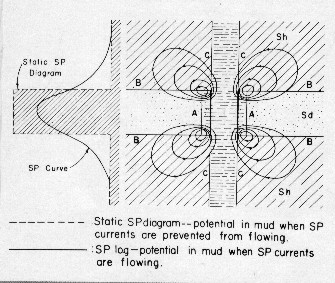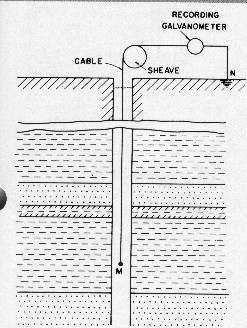|
 SP BASICS
SP BASICS
During the early days of resistivity logging, it was
observed that natural potentials existed in boreholes. These
are known as spontaneous potentials, or SP. A recording of
the changes in SP versus depth gives the SP log. The measurement
is very simple: the potential difference between an electrode
M on the probe and a reference electrode N placed at the surface
is measured with a voltmeter. The voltage is
quite small, ranging from +50 to about –200 millivolts.
This is a passive measurement. That
is, no energy is provided by the logging tool. There is no
SP until the borehole is drilled and filled with conductive
muds. This contrasts with telluric currents caused by solar
radiation and Northern Lights, and man-made currents from power
lines, cathodic protection of pipelines, and welding equipment
grounded to the rig while logging proceeds. All these currents
can persist without a borehole, but more importantly, can cause
anomalies on the SP log, and in some cases rendering it useless.
References:
1. The SP Log: Theoretical Analysis and Principles of Interpretation,
H.G. Doll, AIME, 1948.
2. SP Log in Shaly Sands,
H.G. Doll, JPT, 1950.
3. Natural Potentials in Well Logging
W.D. Mounce, W. M. Rust, Jr., AIME, 1948
 SP THEORY
SP THEORY
The SP is the result of several electromotive
forces: shale membrane potential Em, liquid-junction potential
Ej, and electro-kinetic potential Ek. The measured SP is the
sum of these three voltages.
Shales are permeable to sodium ions
(Na+) but impervious to chloride ions (Cl-). When a shale separates
two sodium chloride solutions of different concentration (the
mud in the borehole and the water in the formation), sodium
ions migrate by diffusion from the higher concentration into
the lower concentration. This movement of positive charges
builds up a voltage known as shale potential or membrane potential
Em.
When two sodium chloride solutions
of different concentration are separated by a semi-permeable
partition that permits the passage of ions from one side to
the other, but prevents bulk mixing of the two solutions, ions
migrate by diffusion from the concentrated solution to the
dilute solution. This happens at the boundary between the invaded
and un-invaded zones. The negative chloride ions have a greater
mobility than the positive sodium ions. There is a net transfer
of negative electric charges from the more concentrated solution
to the less concentrated. The resulting electromotive force
is known as the liquid-junction potential Ej.
The passage of an electrolyte through
a porous medium also produces an electromotive force, called
electro-kinetic potential, Ek, between any two points along
the electrolyte flow path. For example, an electro-kinetic
potential is developed when mud filtrate passes through a mud
cake into the formation. The value of this potential is small
and is commonly disregarded in electrical logging.
The current loops shown below circulate
between shale, borehole, invaded zone, and un-invaded zone
and back to the shale. They represent the sum of membrane and
liquid junction potentials, which is known as the electrochemical
component of the SP. The curve to the left is
the corresponding SP curve as measured by a real tool. The
square static SP is the theoretical shape of a perfect SP curve.

Current path is between mud in borehole,
formation water and nearest shale. Static SP is
theoretical
value; smooth curve shows actual values recorded. High
resistivity in any part of
the circuit reduces the SP. Low contrast in the salinity between
mud and formation
reduce the SP value.
The numerical values of the electromotive
forces depend on the type and quantity of dissolved salts.
The electrochemical component of the SP is defined mathematically
by:
1: Ec = Em + Ej = –K * log(Aw / Amf)
Aw and Amf are
the chemical activities of the formation water and mud filtrate,
respectively. K is a factor that depends on the temperature.
For clean sands and sodium chloride solutions, K ranges from
67 millivolts at 50 F to 123 millivolts at 300 F.
In situations with pure sodium chloride (NaCL) solutions,
the SP equation becomes:
2: SP = –K * log(Rmf /
Rw)
Rw and Rmf are the water and mud filtrate resistivity at formation
temperature respectively.
K is reduced
when the permeable beds contain dispersed clay, so the SP is
sometimes used as shale indicator.

SP Circuit Diagram. The M electrode
is the same electrode as the M on the normal
measurement. N
is a separate grounding electrode thrown into the mud pit or
clamped
to the casing in dry or frozen territory.
|

